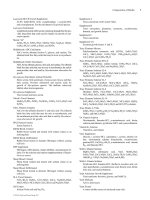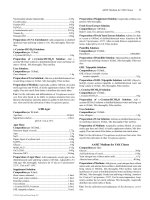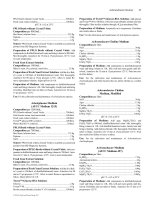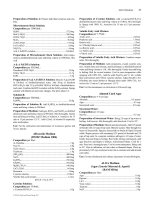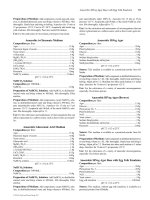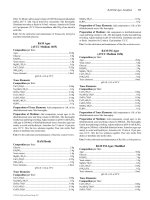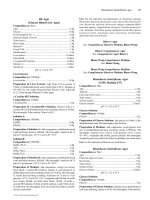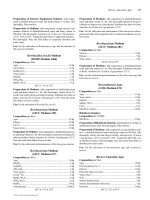Handbook of Polymer Synthesis Second Edition Episode 10 pps
Bạn đang xem bản rút gọn của tài liệu. Xem và tải ngay bản đầy đủ của tài liệu tại đây (1.03 MB, 56 trang )
10
Poly(vinyl aldehyde)s, Poly(vinyl ketone)s, and
Phosphorus-Containing Vinyl Polymers
Oskar Nuyken
Technische Universita
¨
tMu
¨
nchen, Garching, Germany
I. POLY(ACROLEIN)
(This section was prepared by O. Nuyken, T. Po
¨
hlmann, R. Vogel and U. Anders.)
Acrolein (propenal, acrylaldehyde) is the simplest unsaturated aldehyde, a colorless
and volatile liquid with high toxicity and lachrymal irritability [1,2]. The first synthesis
from glycerol and from fats by pyrolytic decomposition was described by Redtenbacher
in 1848 [3]. Among its typical reactions he recognized that upon standing the fluid acrolein
is spontaneously converted to a white, soli d, infusible, and insoluble pro duct he called
disacryl. Later this substance has been proven to be the result of a spontaneous
polymerization [4–8]. But it was not before the early 1940s that the career of acrole in as a
‘key compound’ in organic chemistry began [9,10]. It is mainly used in the production
of
D,L-methionine and acrylic acid. In polymer chemistry, however, none of the acrolein
homopolymers has until now achieved technical significance, although the monomer
is difunctional and highly reactive, and the polymers are susceptible to modification
reactions [11–13].
A. Manufacture of the Monomer
The oldest method for the preparation of acrolein, the acid-catalyzed thermolysis of
glycerol (dehydration) at about 190
C, is still used today to obtain acrolein on a
laboratory scale [3]:
ð1Þ
Copyright 2005 by Marcel Dekker. All Rights Reserved.
By support of KHSO
4
the yield can be enhanced up to 50% [14]. Further possibilities
are the reaction of gaseous propene with a suspension of HgSO
4
in aqueous sulfuric
acid [15]:
ð2Þ
or the pyrolytic cleavage of 2,3-dihydropyrane [16,17]:
ð3Þ
The first efficient and profitable manufacturing process for acrolein was established
by Degussa AG, Germany, in 1942 [8,18–20]. It depends on the gas-phase condensation
(addition and dehydration) of formaldehyde with acetaldehyde at 300 to 320
C. In the
presence of alkaline silica gel catalysts yields as high as 82% were achieved.
ð4Þ
In 1945, at the same time that the Shell Company commercialized the pyrolysis of
diallyl ether [21], acrolein production began.
ð5Þ
With the supply of large amounts of propene in the 1950s the search began to find
a system for its direct oxidation with molecular oxygen to yield acrolein. Attempts with
cuprous oxide marked the beginning of the technical development of alkene oxidation
in the gas phase by metal oxide catalysts [22]. But this system showed weak points in
the conversion (20%) [23,24] and in the selec tivity, with the consequence that most of
the propene added had to be recycled and many side products had to be removed. The
development and introduction of the bismuth molybdate/bismuth phosphomolybdate
system (Sohio, 1957) as a catalyst [25–27] and the following application for propene
Copyright 2005 by Marcel Dekker. All Rights Reserved.
oxidation opened the door to problem control. Specifically, for the system BiPMo
12
O
52
catalyst on a SiO
2
support, a reasonable selectivity (maximum 72%) could be observed.
However, the propene conversion (57%) was still low. By a further development toward
modern multicompound metal oxide catalysts [28] the propene conversion could be raised
from 90 to 98% with a maximum yield of 80 to 90%. The main side product (ca. 5 to 10%)
is acrylic acid, which can be removed by distillation.
Examples of catalysts are:
FeMoBiCoNiP oxide [29] (Nippon Kayaka), FeMoBiCoNiPK oxide [30] (Nipp on
Kayaka), FeMoBiCoNiPSm oxide [31,32] (Degussa), MoBiFeCoWKSNaLi oxide [33]
(Nippon Shokubai), MoBiFeP oxide [34] (Farbenwerke Hoechst).
Common conditions for a good performance are:
300 to 400
C reaction temperature, 1.5 to 3.5 s contact time, 5 to 8 vol% propene
concentration, 150 to 250 kPa inlet pressure, 1 : 10 to 20 : 1% molar ratio pro pene/air/gas
passed over a solid catalyst of suitable shape.
B. Radical Polymerization
Acrolein, a member of the family of the polymerizable 2-alkenales and 2-alkenones,
is provided with an extraordinary tendency for polymerization. Therefore, it may only be
stored in the presence of a stabilizer (e.g., hydrochinone) in the absence of light, air, and
moisture because of spontaneous polymerization. Even small amounts of initiator have the
ability to force acrolein polymerization radically, anionically, or cationically, partly in an
explosive manner. According to the existing reaction conditions and the catalysts used,
it is possible to attain polymers of completely different shapes with characteristic features
[9,13,35].
Radical polymerization prinicipal ly proceeds ac ross the vinyl functio n [1,2-addition;
Scheme (6a)], whereas ionic polymerization yields products mainly by an addition at the
carbonyl group [3,4-addition; Scheme (6b)]. However, the third possibility, 1,4-addition
across the a,b and C,O double bond, is a subordinate process [Scheme (6c)] [12,36,37].
ð6aÀc Þ
Copyright 2005 by Marcel Dekker. All Rights Reserved.
Because of the polymerization across one of the two double bonds in acrolein
polymers, the corresponding function remains pendant at the polymer backbone and is
accessible to derivation reactions or for analytical purposes [9,37].
Radical polymerization occurs exclusively across the vinyl function. The remaining
pendant formyl groups form hydrates and acetales without effort by intra- and inter-
molecular condensation. The following structure elements are able to arise, including the
characteristic tetrahydrop yrane rings [38–40]:
ð7Þ
Due to numerous chain cross-linkings by actetal groups, radically manufactured
acrolein polymers are insoluble in water and in organic solvents. They decompose above
200
C without fusing. The polymerization itself is carried out in bulk, in aqueous solution,
and in organic solvents. The Polymer precipitates from the solut ion and can be removed
by filtration [11]. To start the polymerization the following initiators are used: inorganic
peroxides [41] , organic peroxides [42,43], azo compounds [42,43], redox initiators [43–45],
g-rays and others [46–49].
1. Polymerization in Bulk
The first spontaneous curing of acrolein observed was also the first polymerization in
bulk [3]. Later, this observation was examined more closely [4–6,50–52]. Furthermore, a
slow light- or g-ray-initiated polyme rization is possible, yielding highly cross-linked glassy
products [46,53,54]. By means of AIBN or peroxides as initiators an explosive course
of the reaction is observed that causes problems in the carriage of the reaction heat [42,55].
Therefore, working with only small amounts is recommended.
2. Precipitation Polymerization
The heat problem does not occur during polymerizations in aqueous solution. At 20
C
acrolein is soluble to 21.4% in water, wher eas the polymer precipi tates from the solution
at molecular weights above 50,000 g/mol. The polymerization is started with water-soluble
initiators or redox systems. In the case of redox initiators, H
2
O
2
,S
2
O
8
2À
,P
2
O
4
4À
, and
organic peroxides and hyperoxides serve as oxidizing agents. Typical reducing agents are
Copyright 2005 by Marcel Dekker. All Rights Reserved.
Ag(I), Fe(II), and Tl(III) compounds, Na
2
SO
3
, NaNO
2
, and polyacrolein hydroxysu lfonic
acid [13,41,42,56,57]. It is favorable to add the reducing agents to the aqueous solution of
the oxidizing agent and acrolein.
3. Polymerization in Emulsion
A very favorable way to obtain acrolein polymers having molar masses of some
100,000 g/mol is by emulsion polymerization [43,58–62]. In oil–water emulsions the
water-soluble addition compounds of sulfuric acid (respectively, SO
2
) and polyacrolein are
used as very suitable emulsifiers to produce stable polymer dispersions. The emuls ion
polymerization is started by water-soluble redox initiators. The acrolein polymers
containing adsorbed or chemical bond SO
2
serve as reducing agents. Together with air in
combination with oxygen donors [e.g., Fe(NO
3
)
3
Á 9H
2
O, H
2
O
2
,K
2
S
2
O
8
], a powerful redox
system is designed [63–65]. Further examples are the systems K
2
S
2
O
8
/AgNO
3
[60,61],
K
2
S
2
O
8
/(NH
4
)
2
SO
4
–Fe(II) compounds, and K
2
S
2
O
8
/Na
2
SO
3
[55]. Other soluble polymers,
such as gelatine, PVA, or methyl cellulose, combined with sulfuric acid or SO
2
, also
accomplish the double function of emulsifier and reducing agent [63,64]. Polymerization in
the inverse emulsion (water–oil) has also been described [66,67]. Aliphatic and aromatic
hydrocarbons make up the continuous phase, and acrolein exists in the aqueous phase.
4. Polymerization in Solution
The monomer is soluble in numerous solvents; however, the polymer precipitates
from most of these solvents at about 15% conversion during radical polymerization.
Molecular weights up to 100,000 g/mol and aldehyde contents above 65% can be
achieved when the polymerization is carried out in polar solvent s such as DMF,
g-butyrolactone, or pyridine by means of hydroperoxides and nitrous acid derivatives
as redox catalysts [68]. Deviations from this behavior are observed if DMF is used
as solvent and the polymerization is initiated by AIBN. A microgel is formed here;
after 16% conversion the clear reaction solution turns into a transparent gel [69].
Polymerization in the presence of methanol initiated by means of azo compounds
or peroxides does yield soluble poly(acrolein), presumably because of the polymer’s
molecular weight [70].
5. Radiation-Induced Polymerization
Bulk polymerization of acrolein under the influence of g-rays yields a highly cross-linked
glassy polymer, which is completely insoluble in organic solvents and also in aqueous
sulfuric acid. Gamma-ray-induced polymerization in solution, especially in water, is much
faster than in bulk [46–48 ,54]. Investigations of radiation-induced polymerizations in bulk
or in aqueous solution by means of a
60
Co source yielded microspheres of different size
containing reactive formyl functions [49,71,72].
6. Solubilization of the Polymers
To solubilize the products of radically induced acrolein polymerization, the following
procedures are used.
Copyright 2005 by Marcel Dekker. All Rights Reserved.
Disproportionation of the aldehy de and acetale groups pending on the polymer
backbone by means of sodium hydoxide solution (Cannizzaro reaction) [73–75]:
ð8Þ
Formation of water-soluble addition products by the action of sodium bisulfite and
aqueous sulfurous acid [76–78]:
ð9Þ
By dialysis of the primary addition product, the following equilibrium can be forced
to the right side yielding water-soluble, SO
2
-free acrolein hydrate [79]:
ð10Þ
C. Ionic Polymerization
1. Anionically
In the presence of alkaline metal hydroxides or carbonates, acrolein is converted into oily
resinous products [5,6]. This reaction proceeds in a vigorous-to-explosive way by means of
strong bases and amines [13]. In the 1950s this techniques was used to produce polymers by
anionic polymerization in solution under well-defined conditions. In THF, DMF, toluene,
glyme, and other solvents, products with melting and softening points between 90 and
200
C were obtained which were soluble in organic solvents but insoluble in sulfurous acid
[80,81]. Structural analysis of the polymer’s repetition units gave rise to the assumption that
chain growth occurs mainly across the carbonyl group (3,4-polymerization,
-
structure units) [37,81]. Furthermore, there is addition across the vinyl function (1,2-
addition) and across both functional groups (1,4-addition) [82,83]. The latter takes place
only on a very small scale. Consequently, copolymers are formed that contain the following
structure elements:
, partly in block arrangement (n þ m ¼ 1; m ¼ 0.7 to 0.8) [84].
In a water-free medium chain growth polymerization can be initiated by numerous
metal-organic or basic compounds, such as trityl sodium [81], butyl lithium [80,81],
naphthyl sodium [80,81], benzophenone potassium [81], sodium methoxide [80,81], lithium
organocuprates [85] and rhodium(I) complexes [86] or ammonia [87], tert-phosphines
[80,88], aliphatic amines [89], cyclic amines [90], and aromatic amines (pyridine [91,92],
Copyright 2005 by Marcel Dekker. All Rights Reserved.
imidazole [93,94], N-ethylimidazole [95]). The reaction temperatures range from À 60
Cto
þ 25
C, whereby the reaction rates as well as the properties of the products (composition)
are influenced. Higher temperatures lead to products having a higher content of aldehyde
side groups and a lower content of vinyl side groups. Weaker bases and solvents with lower
polarity also favor the formation of polymers with aldehyde side groups [81]. Acrolein
can be polymerized by alkali cyanides in polar solvents such as THF or DMF [96,97].
At reaction temperatures below À 10
C, only 3,4-connected products were obtained.
2. Cationically
Few sources describe the cationic acrolein polyme rization in bulk or in homogeneous
solution [7,12,42,80,98]. Using trifluoroborane-diethyl ether or triethyloxonium-tetra-
fluoroborate as initiators carbonyl and vinyl group containing polymers are obtained at
reaction temperatures ranging from À 80
C to room temperature. The carbonyl content of
these polymers varies from 9 to 15 mol%. For this polymerization polar solvents such
as nitromethane or nitrobenzene are favorable. When the polymerization is stopped at
low conversion soluble products (cf. in 1,4-dioxane, CHCl
3
, THF, pyridine) are obtained.
Adding tert-amines during the last step of the polymerizations results in the highest content
of carbonyl polymerization [9]. At higher conversions or at prolonged storage the products
become cross-linked and insoluble. All these products soften between 80 and 120
C.
D. Copolymerizations
1. Radical Copolymerization
For a list of various characteristics of radical copolymerization, see Table 1.
2. Graft Copolymerization
Acrolein can be grafted onto poly(methyl methacrylate), cellulose, and poly(ethylene) by
g- or electron-beam radiation.
1. A foil of poly(methyl methacrylate) was swollen in aqueous or methanolic
acrolein solution and then exposed to g-radiation of a
60
Co source. Graft
polymers with aldehyde groups were formed, which show the specific aldehyde-
type reactions [46].
2. Cellulose dispersed in an acrolein solution (solvent: water, ethanol, acetone,
ether, or benzene) was treated with g-radiation of a
60
Co source at 40 to 43
C.
In addition to the formation of a network of cellulose, homopolymerization
of acrolein was observed. Homopolymerization of acrolein could be avoided if
cellulose was treated with gaseous acrolein at a pressure of 10
À3
torr before
radiation [106].
3. Acrolein was grafted onto poly(ethylene) which was exposed to electron beams.
The remaining aldehyde groups could be transformed into hydrazon e, oxime,
and oxyacid units [107].
3. Oxidative Copolymerization
Acrolein and acrylic acid were copolymerized in aqueous H
2
O
2
solution at 60 to 90
Cto
form poly(aldehyde carbon acids). The Cannizzaro reaction took place if an aqueous
Copyright 2005 by Marcel Dekker. All Rights Reserved.
solution or suspension of this polymer material was treated with aqueous NaOH.
The aldehyde functions disproportionated into carboxylate and alcohol groups to form
poly(hydroxy carboxylates) [108,109].
4. Anionic Copolymerization
Acrolein was anionically copolymerized with acryl amide and methyl vinyl ketone
(r
1
¼ 2.02, r
2
¼ 0.06) at 0
C in THF with imidazole as an initiator [110]. Copolymeriza-
tions of acrolein with various aldehydes (e.g., acetaldehyde and benzaldehyde) were
carried out in THF at À 30
C with NaCN as initiator [111].
5. Block Copolymers
1. Living oligomers of butadiene were functionalized by the addition of acrolein
or ethylene oxide and then treated with acrolein to yield block copolymers. The
homopolymerization of acrolein could not be avoided [112,113].
2. Short poly(acrolein) blocks were formed, if a,o-disodium oligobutadiene
(initiated with sodium naphthal ene in THF at À 40
C) was treated with
Table 1 Parameters of the radical copolymerization.
Monomer M
2
r
1
r
2
Temp (
C) Initiator Solvent Refs.
Acrylic acid 0.50 Æ 0.30 1.15 Æ 0.20 54 AIBN Water
a
[99]
2.40 Æ 0.50 0.05 Æ 0.05 75 AIBN Water
b
[99]
6.70 Æ 3.00 0.00 80 AIBN Water
c
[99]
Acryl amide 2.0 Æ 0.05 0.76 Æ 0.02 20 K
2
S
2
O
8
þ AgNO
3
Water [100]
1.69 Æ 0.1 0.21 Æ 0.02 50 AIBN DMF [101]
Acryl nitrile 1.09 Æ 0.05 0.77 Æ 0.1 20 K
2
S
2
O
8
þ AgNO
3
;
H
2
O
2
þ NaNO
2
Water [100]
1.60 Æ 0.04 0.52 Æ 0.02 50 AIBN DMF [101]
Butyl acrylate 1.6 0.6 50 K
2
S
2
O
8
Water [102]
1.6 0.6 60 AIBN Dioxane [103]
1.2 0.6 60 AIBN
Ethyl acrylate 1.6 0.6 50 K
2
S
2
O
8
Water [102]
AIBN Dioxane [103]
Maleic hydrazide 16 0 60 AIBN DMSO [104]
Maleimide 3.20 0.12 60 AIBN DMSO [104]
Methacryl nitrile 0.72 Æ 0.06 1.20 Æ 0.08 50 AIBN Dioxane [101]
Methyl acrylate $ 0 7.7 Æ 0.2 20 K
2
S
2
O
8
þ AgNO
3
Water [100,101]
1.6 0.6 50 K
2
S
2
O
8
Water [102]
1.2 0.6 60 AIBN Dioxane [103]
Methyl 0.5 1.0 50 K
2
S
2
O
8
Water [102]
methacrylate 0.8 1.2 60 AIBN Dioxane [103]
Styrene 0.034 0.32 50 K
2
S
2
O
8
Water [102]
0.25 0.25 60 AIBN Dioxane [103]
0.22 0.33 50 AIBN Dioxane [105]
Vinyl acetate 3.33 Æ 0.1 0.1 Æ 0.05 20 K
2
S
2
O
8
þ AgNO
3
Water [100]
2-Vinyl pyridine $ 4 $ 0 50 AIBN DMF [101]
a
pH 3.
b
pH 5.
c
pH 7.
Copyright 2005 by Marcel Dekker. All Rights Reserved.
acrolein. Homopolymerization of acrolein did not take place. The acrolein units
could be cross-linked after an UV cure to form a poly(acrolein) network that can
be used as photo-polymer layers to prepare negative printing plates [114].
6. Graft Copolymerization
Acrolein could be grafted onto imidazole-containing polymers [poly4(5)-vinylimidazole)
or copolymers of 4(5)-vinylimidazole with acryl amide, styrene, 1-vinyl-2-pyrrolidone,
4-vinylpyridine, acrylates, and methyl vinyl ketone] in ethanol or an ethanol–water
mixture at 0
C under nitrogen [115–117].
7. Cationic Copolymerization
Cationic copolymerization of acrolein with styrene took place in methylene chloride,
toluene, and 1-nitropropane with bortrifluoride-etherate as a catalyst at different
temperatures (À 78
Cto0
C) [118].
E. Modification Reactions of Poly(acrolein)
1. Radically Polymerized Acrolein (Redox Poly(acrolein))
Redox poly(acrolein) is one of the most reactive polymers and susceptible to a number
of modification reactions that lead to high conversions under mild conditions [9,11,37].
Containing one pendant aldehyde function per repetition unit – either free or masked –
poly(acrolein) possesses functional groups and can react basically in the following ways
[37,39,40]:
(a) As a Polymeric Monoaldehyde (i.e., after the pyran rings’ cleavage, the aldehyde
functions developed react independent of each other). Examples are oxidations [119]
(e.g., with peracetic acid) and reductions [120,121] [e.g., to poly(allylalcohol)] of the C,O
group, or reactions with alcohols to acetales [122], amines to imines [39,123],
hydroxylamine to oximes [124], or phenylhydrazine to hydrozones [39,123]. The latter
serve for the quantitative determination of the aldehyde group content.
(b) In Condensation Reac tions. Representative reactions are aldol condensation
[125,126] with formaldehyde taking place at the polymers’ a-carbons, and Knoevenagel
condensation [40,127] with C,H acidic compound s (e.g ., malodinitrile).
ð11Þ
ð12Þ
Copyright 2005 by Marcel Dekker. All Rights Reserved.
(c) As a Polymeric Dicarbonyl Compounds. For reasons of their masking in the
form of pyran rings, reactions are favored in which two adjacent carbonyl functions are
involved. The intramolecular disproportionation reaction by Cannizzaro serves as a well-
known example. Un der the action of alkal i and due to the proximity and reactivity of the
aldehyde groups, polymers with pendant hydoxymethyl (CH
2
OH) and carboxylate
(COO
À
) groups are formed [73–75].
ð13Þ
(d) As a Polymeric Semiacetate. The semiacetale hydroxy groups are able to
perform characteristic reactions without cleaving the pyran ring structure (e.g., thiol
addition) [128].
ð14Þ
Because of the insolubility of redox poly(acrolein) [129], modification reactions must
always start in heterogeneous systems and lead to soluble products gradually. The already
presented water-soluble products of the reaction between poly(acrolein) and Na
2
SO
3
or
H
2
SO
3
[76–78] are still better precursors for modification reactions than is native redox
poly(acrolein). They permit a reaction performance in homogeneous media.
Apart from conversions with low-molecular-weight compounds, solub le and
insoluble redox poly(acrolein) can react with high-molecular-weight substrates. Connec-
tions with the following in vivo and in vitro occurring polymers are good examples of that
behavior: poly(vinyl alcohol) [130,131], cellulose [130–132], proteins [130,131,133,134]
(e.g., collagen, gelatine [135]), enzymes [130,136,137], lectins [138,139], erythrocytes
[140–142] and lymphocytes [140], leukemia cells [140,142], antibodies [133,143,144], and
metal complexing agents [145].
2. Anionically Polymerized Acrolein
Due to the high portion of pendant vinyl groups, the following reactions of this polymer
material are possible:
1. Co- and graft polymerization with vinyl and acryl monomers in the form of a
two-step copolymerization process [146].
2. Autoxidation of the double bond and a subsequent connection with the
polymers’ remaining aldehyde functions [81] .
3. Light-induced cross-linking across the vinyl group [147].
Copyright 2005 by Marcel Dekker. All Rights Reserved.
F. Applications and Economic Aspects
The statement that acrolein homopolymers do not find technical applications does not
hold for copolymers. The already introduced poly(aldehyde carbon acids) (trade name
POC, Degussa, Germany) are strong complexing agents [108,109,148–151]. They are able
to form complexes with cations such as Na
þ
,Mg
2þ
,Ca
2þ
,Fe
3þ
,Mn
2þ
,Cu
2þ
[152] (also
reversible), with gaseous ammonia [11], with peroxides for stabilization purposes, or
with amino acids. The material is used in water treatment as a water softener in detergents
or rinsing agents, and as a supported sequestering agent showing rising complexing
activity with increasing aldehyde content. The ability to bind amino acids is utilized in the
determination of the C-terminated end in proteins [153].
On a laboratory scale, acrolein homo- and copolymers are tested as polymeric
reagents, polymeric complexing agents, and polymeric carriers. Poly(acrolein) micro-
spheres can easily be bound to antibodies, proteins, and drugs containing primary amino
groups in a single step under physiological pH [71,72,139–145,154,155]. Aldehyde groups
react under mild conditions wi th primary amino groups forming the corresponding imino
(Schiff base) linkage. Reaction with sodium cyanoborhydride as reducing agent forms a
stable –CH
2
–NH– linkage [134].
ð15Þ
In this way poly(acrolein) particles may play an important role as immunoreagents
for biological research.
II. POLYMERS OF CROTONALDEHYDE AND METHACROLEIN
(This section was prepared by O. Nuyken, R. Bayer and J. Bayer.)
A. Crotonaldehyde
1. Properties and Structure
Crotonaldehyde (2-butenal, crotonic aldehyde, b-methacrolein) is a colorless, strong
lacrimatory, and toxic liquid. The mutagene potential of crotonaldehyde and its role in
cancerogenese has been investigated [156–159]. It has a melting point of À 69
C and a
boiling point of 102.2
C. Crotonaldehyde and water form an azeotrop containing 24.8%
water and boiling at 84
C. Other physical properties are given in Refs [160] and [161]
and the literature cited therein. Technical crotonaldehyde consists of two isomers,
Copyright 2005 by Marcel Dekker. All Rights Reserved.
where trans-crotonaldehyde has an occurance of more than 95%.
ð16Þ
The very reactive crotonaldehyde is easily oxidiz ed by con tact with air [162–169].
This causes resinifying and darkening. Avoiding the formation of peroxides and iron salts,
it can be stored without adding inhibitor. The usual inhibitors are water and hydro-
quinone. In contact with strong acids, crotonaldehyde forms a dimer that can be separated
into cis-andtrans-isomers [170].
2. Synthesis
The general method of producing crotonaldehyde is the aldol condensation of
acetaldehyde, followed by dehydration and rectification respectively extraction [160,171].
ð17Þ
More details and other synthesis routes are given in Ref. [160].
3. Anionic Polymerization
Anionic polymerization is the best investigated and the most used method to polymerize
crotonaldehyde. A great number of publications about the anionic polymerization of
crotonaldehyde deals with a method that was first used by Koral [172,173]. The initiation
occurs through tertiary phosphines (see Table 2). Koral proposes the following initiation
step:
ð18Þ
The fact that the rate of polymerization of crotonaldehyde increases with the
dielectric constant of the solvent is evidence for an ionic mechanism of the polymerization.
An increase in dielectric constant of the medium will favor energetically an increase in the
rate of initiation and the stabilization of the zwitterion [172]. It should not influence the
rate of propagation and termination.
Radical anions generated from metal–organic compounds are another group of
initiators. Based on polarographic investigations and Hu
¨
ckel calculations it was shown
that the polymerization of crotonaldehyde with benzophenone radical anions proceeds via
formation of a complex radical anion of crotonaldehyde [174]. This complex accepts a
Copyright 2005 by Marcel Dekker. All Rights Reserved.
second electron from another benzophenone radical anion and a dianion is built that is
capable to grow and to build up the polymer chain. This mechanism was corroborated by
isolating 2,2
0
-diphenyl-3-methyl-5-hydroxytetrahydrofurane from the solution [175]. Its
formation can be explained by the following mechanism:
ð19Þ
The dianion is able to grow a polymer chain.
Numerous initiators have been reported to be used in anionic polymerization of
crotonaldehyde. Some are shown in Table 2.
Varying the conditions of the polymerization (initiators, temperature, solvent, etc.),
polymers with different structures can be prepared. Anionic initiators are leading to
polymers containing monomer units bonded together via C–C– or C–O-linkages.
ð20Þ
In the case of polycrotonaldehyde using sodium dihydronapthalide as initiator, both types
of linkages were found [184] . An important change in the structure of the polymer chain
Table 2 Common initiators for anionic polymerization of crotonaldehyde.
Name
Max. molar
mass reached
Refs.
2,4-Dimethylbenzophenone [175]
4-Methylbenzophenone [175]
1-Benzoylnaphthalene [175]
Benzophenone [175]
4-Benzoyl bichloride [175]
Xanthone [175]
Potassium diphenylketyle 10,000 [185]
Potassium dihydronaphthalide [185]
Potassium graphite inclusion compounds [185]
t-Phosphines (Pr
3
P, Bu
3
P, PhEt
2
P, Ph
3
P) 3,270 [172,173,176,177]
NaCN 350 [176]
Et
3
N 560–830 [178]
Sodium hydroxide 1,000 –10,000 [179–183]
Sodium naphthalene, Sodium methanolate [184]
Various inorganic salts (e.g., K
2
CO
3
, NaNH
2
) [182,183]
Copyright 2005 by Marcel Dekker. All Rights Reserved.
was found by Rashkov et al. [185]. They compared the polymers star ted with
homogeneous initiators (e.g., potassium ethoxide) with heterogeneous initiators (e.g.,
graphite inclusion initiators such as C
8
K). Homogeneous initiators cause polymerization
of the aldehyde groups even at low temperatures (e.g., 10 and 30
C). Heterogeneous
initiators inhibit the side reaction of the aldehyde groups so only the vinyl groups
polymerize even at high temperatures and concentrations of the monomer and/or initiator.
The authors assume that the propagation of the active chain predominantly proceeds on
the surface of the heterogeneous initiator.
Generally it was found that at low temperatures the polymerization of aldehyde
groups proceeds to a larger degree [184,185].
A different polymer structure was obtained by using tert-phosphines as initiator.
Koral [172,173] found a large amount of free carbonyl groups (conjugated and
unconjugated) and ether groups together with a small hydroxyl concentration and some
residual unsaturation. This structure results from a vinyl-type polymerization with
a simultaneous cyclization of some vicinal, pendant aldehyde groups. The following
structure is proposed:
ð21Þ
The anionic polymerization of crotonaldehyde was also carried out under high
pressure with Et
3
N [186]. It was found that the melting point and molar mass of the
polymer increase linearly with rising pressure or temperature.
4. Cationic Polymerization and Field Polymerization
Cationic polymerization of crotonaldehyde is less important than anionic polymerization.
With (EtO)
3
Al or (i-PrO)
3
Al as initiators, rather unstable polymers were obtained [187];
with H
3
PO
4
and PCl
5
only oil was formed [188]. Polymerizati on of crotonaldehyde can
also be induced by high electric fields (several 10
7
V/cm) [189]. Field polymerization results
in the growth of organic semiconducting micro needles with side-chain cross-linking and
P
max
¼ 3.
5. Step-growth Polymerization
The polymerization of crotonaldehyde and several amines (butylamine, ethylenediamine,
triethylenetetramine, diethylenetriamine, hexamethylenediamine, aniline, melamine, and
diaminodiphenylmethane respectively diaminomaleonitrile) proceeds in two steps. In the
first step a Schiff-base-reaction between the aldehyde groups and the amino groups take
place. In the second step the vinyl groups disappear due to step-growth-polymerization
and lead to resins [190–196]. The step- growth-polymerization of crotonaldehyde and
alcohols like phenols and glycols leads to resins, too. A review is given in Ref. [160].
Copyright 2005 by Marcel Dekker. All Rights Reserved.
6. Copolymerization
Crotonaldehyde acts in copolymerization (with styrene, methacrylic esters, vinyl esters,
vinylcaprolactam) as a retarder, and therefore only oligomeric products can be isolated
[160,197].
7. Applications
Copolymerization of crotonaldehyde with quinol forms a resin, that chelate divalent
cations (e.g., Mg, Co, Fe, Cu, or Cd) [198].
Polycrotonaldehyde bearing specific ligands is used for the removal of drugs
and diagnostic substances from blood, which have long half-live times in blood. The
microparticles (0.1 up tp 6 mm size) agglomerate and are taken up by the mononuclear
phagocytic system) [199]. Cyanoacrylate/crotonaldehyde-copolymers are used for building
up dental compositions [200]. Citric acid were produced by hydrolysis of the polymeric
product of the lactonization of crotonaldehyde with ketene and water [201–203].
ð22Þ
The copolymerization of pyrrole, crotonaldehyde, and a polymerizable, organic acid
leads to water-based resins or coating compounds [204].
B. Methacrolein
1. Properties and Reactions
Methacrolein (2-methylpropenal, methacrylaldehyde, 2-methylacrolein, a-methylacro lein)
is a colorless, sharp (stinging) smelling, flammable, highly reactive, and lacrimatory liquid
with a melting point of À 81
C and a boiling point of 68.4
C. Methacrolein and water
form an azeotrop containing 6.7% water and boiling at 63.9
C. The solubility in water is
6% at 20
C. Other properties are described in Refs. [205–207].
ð23Þ
The reactions of methacrolein are analogous in many respects to those of acrolein.
Dimerization of methacrolein occurs similar to the dimerization of acrolein via Diels–
Alder addition, where methacrolein reacts both as a diene and a dienop hile [205] . By
treatment with alkali tri-, tetra-, and pentamers are formed by Michael addition [208,209].
By exposure to air, methacrolein forms peroxides and acids. The peroxide groups can be
incorporated into the polymer chain [208]:
ð24Þ
Copyright 2005 by Marcel Dekker. All Rights Reserved.
Avoiding air by storage under nitrogen and avoiding iron salts [210], no inhibitor
(hydroquinone) is required.
2. Synthesis
The following methods are used to synthesize methacrolein:
1. Catalytic oxidation of isobutane with oxygen [211–216]:
ð25Þ
2. Catalytic oxidation of isobutylene with oxygen [206,211,219–226]:
ð26Þ
3. Catalytic oxidation of tert-butanol with oxygen [206,211,219–227]:
ð27Þ
4. Cross-condensation of propionaldehyde and formaldehyde with catalysts in the
vapor phase followed by dehydration [206,228]:
ð28Þ
5. Catalytic oxidation of b-methallyl alcoho l [229,230]:
ð29Þ
6. Catalytic oxidation of isobutyraldehyde [231]:
ð30Þ
Copyright 2005 by Marcel Dekker. All Rights Reserved.
For laboratory use methacrolein can also be prepared by heating of Mannich
aldehydes [232].
3. Radical Polymerization
Methacrolein polymerization can be carried out in bulk, inorganic solvents, and in water.
Heating methacrolein without initiator gives a brittle, yellow polymer which does not
contain any free aldehyde groups. Contrary to this free aldehyde groups were found by
initiation with peroxo or azo compounds [233]. The polymer was described as clear and
glassy. For the radical polymerization of methacrolein in organic solvents, peroxo or azo
compounds were used [79]. With ammonium peroxodisulfate in DMF, molar masses of
5,000 up to 21,000 g/mol were reached [234]. The polymerization is aqueous media can be
carried out in different ways:
1. Precipitation polymerization with redox systems [235,236] or peroxo compounds
[208,237] as initiators. Using peroxo compounds, the resulting molar masses are
relatively low (maximally reached 30,000 g/mol) due to the monomer causing
chain transfer [208]. This effect is also known from other aldehydes.
2. Suspension polymerization [238].
3. Emulsion polymerization [233,239–241]. In an extended investigation of the
redox system K
2
S
2
O
8
–Na
2
S
2
O
5
, Andreeva et al. [240,242,243] found that
polymerization in emulsion failed because the interaction of bisulfite ions with
the monomer at the double bond causes a deactivation of the initiator.
Further, the effect of proton formation during polymerization follows the
equation
S
O
À
4
þ H
2
OÀ!SO
2À
4
þ H
þ
þ O
H ð31Þ
The decrease in pH value that results was investigated with respect to the viscosity of
the polymer solution and the structure of the polymer.
4. Anionic Polymerization
Anionic polymerization of methacrolein was investigated by several authors [244–251].
Homogeneous initiators are the anion radicals of naphthalene [242,246], 2,4-dimethyl-
benzophenone [247], 4-methylbenz ophenone [247], 1-benzoylnaphthalene [247], benzo-
phenone [247], 4-benzoylbiphenyl [247], diphenyl ketone [249], dihydronaphthalene
[249], and also BuLi [250], NaCN [245], and Bu
3
P [245]. Also heterogeneous initiators
such as the radical anions of graphite [251] formed from graphite inclusion compounds
are used.
It has been suggested that the polymerization of methacrolein initiated by
benzophenone or naphthalene anion radicals is accomplished by electron transfer
[246,248]. In the case of benzophenone it was shown by polarographic methods and
Hu
¨
ckel calculations that the complex radical anion with methacrolein (if it is formed) is
unstable and dissociates into benzophenone and the radical anion of methacrolein.
The initiation with heterogeneous inclusion compounds such as C
8
K, C
16
K, or C
24
K
is explained as follows [251]: The initiation is preceded by adsorption of the monomer on
the initiator surface. The monomer molecule absorbs an electron and converts into
an anion radical. The latter remains fixed on the initiator surface due to coulombic
Copyright 2005 by Marcel Dekker. All Rights Reserved.
interactions with the counterion. After recombination of the radical ends, a dianion is
formed that is suitable for propagation. The propagating anion ends probably remain
fixed on the initiator surface.
In general four types of linkages between the monomer units are possible and found
depending on the reaction conditions [249,250]:
1. Bonded via C–C-linkage:
ð32Þ
2. Bonded with C–O-linkage:
ð33Þ
3. Tetrahydropyrane ring structure:
ð34Þ
4. Lactone ring structure:
ð35Þ
The relation of the former two is very sensitive to the polymerization conditions.
At low temperatures polymerization of the aldehyde groups proceeds to a larger degree.
The formation of the dianion (36) was found by Rashkov et al. [249]. The authors showed
with Hu
¨
ckel calculations that the formation of tetrahydropyrane rings in the propaga-
tion reaction of methacrolein is energetically favoured. These calculations lead to the
assumption that these rings are formed as a result of the interaction of dianion (36) with
methacrolein molecules.
ð36Þ
Copyright 2005 by Marcel Dekker. All Rights Reserved.
If the polymerization of methacrolein is initiated by a typical anionic initiator
such as BuLi, the polymer obtained does not contain tetrahydropyrane rings [251].
When sodium dihydronaphthalide at higher temperatures and higher monomer
concentrations is used the formation of the cyclic lactones (35) is observed. Also
side reactions of the aldehyde group take place and the polymers yield is decreased.
Koton et al. [250] assumed that the side reactions with aldehyde groups are due to
the catalytic effect of the propagating anionic ends, consisting of an alcoholate group
–CH–O–Mt
þ
. Here the same result as in the polymerization of crotonaldehyde
is found. By initiation with a typical anionic initiator such as KOEt, side reactions
with the aldehyde groups in the polymer proceed to a considerable extend even
at higher temperatures. In contrast to that the aldehyde groups were not involved
in side reactions if heterogeneous initiators (e.g., graphite inclusion compounds)
are used.
Also methacrolein is the base for new types of monomers like 3-methyl-N-
(phenylsulfonyl)-1-aza-1,3-butadiene as described in [252], which can be polymerized
anionically.
5. Cationic Polymerization
Cationic initiators (BF
3
-etherate, SnCl
4
, or AlCl
3
) are used to form soluble polymers with
free aldehyde groups [253]. Tertiary phosphines in the presence of secondary alcohols at
low temperatures are used by other authors [233].
Also an unsaturated cyclic acetal (2-isopropenyl-4-methylene-1,3-dioxolane), which
is formed from methacrolein and epichlorhydrine, can be polymerized via ring-opening-
cationic polymerization [254].
6. Step-growth Polymerization
Methacrolein and the conjugated amine diaminomaleic dinitrile is stepwise polymerized.
The first step is a Schiff-base reaction between the aldehyde groups and the amino groups.
In the next step the vinyl groups polymerize resulting a resin [195].
7. Methacrolein Copolymers
A general description to prepare copolymers is given in Ref. [207]. Methacrolein
copolymers were described with the following comonomers: (1) styrene and vinyl
compounds [255–262], (2) vinyl idene compounds [263], (3) acrylic acid, derivatives,
and substituted acroleins [255,261,264–266], and (4) derivatives of methacrylic
acid [255,266].
8. Applications
Crosslinked poly(4-vinylpyridine-co-methacrole in) is used as permselective membrane for
reverse osmosis [267].
Polymers of methacrolein (10,000 up to 500,000 g/mol) in combination with alkali
metal sulfides can coagulate heavy metals from municipals wastewaters [268,269].
Derivatation of methacrolein copolymers with NaHSO
3
respectively Na
2
S
2
O
5
produces copolymers with sulfite grou ps which leads to water soluble copolymers
[270–272].
Copolymers of methacrolein are used as coating material for immuno assays
[273].
Copyright 2005 by Marcel Dekker. All Rights Reserved.
III. POLY(METHYL VINYL KETONE)
(This section was prepared by O. Nuyken, A. Riederer and S. Bu
¨
chel.)
Vinyl ketones are an interesting class of monomers because various members of
this group polymerize via a radical, anionic, and cationic mechanism. Methyl vinyl ketone
(MVK) – also named 3-butene-2-one – is its best examined representative. The physical
properties of poly(methyl vinyl ketone) (PMVK) depend on the polymerizatio n conditions
and the degree of polymerization. PMVK ranges from a viscous oil to a hard plastic or
rubbery mass. Polymers obtained with free radical initiators are amorphous materials with
low softening points (about 40 to 80
C) and poor thermal and chemical stability [274,275].
The molecular weights are relatively low because of the lability of the protons in the
a-position to the carbonyl groups.
The polymers are soluble in the monomer and in numerous organic solvents, such as
acetone, methyl ethyl ketone, tetrahydrofurane, dioxane, pyridine, or chloroform. They
are insoluble in aliphatic and aromatic hydrocarbons, carbon tetrachloride, ethyl ether,
and water. The reactivity of the carbonyl groups in homo- and copolymers obtained
from MVK allows many modification reactions. PMVK itself has not found commercial
applications because of its instability, but great effor ts have been made in synthesizing
copolymers with a wide range of physical properties: for example, the preparation of oil-
and solvent-resistant rubbers with butadiene to replace styrene-butadiene rubbers or
the preparat ion of crosslinked resins by treating MVK-butyl acrylate copolymer with
hydrazine or using a divinyl compound as comonomer [275]. Crystalline products are
obtained by anionic polymerization with some organometallic compounds. They are
soluble in formic acid and show melting points of 140 to 160
C [276].
A. Monomer Synthesis
MVK, or systematically 3-butene-2-one, was first synthesized in 1906 by heating
b-chloroethylketone with diethylaniline [277]:
ð37Þ
Alternative synthetic routes are described below.
1. Hydration of vinylacetylene in the presence of mercury salts [278]:
ð38Þ
2. Oxidation of 1-butene (formation of an olefin–mercury–salt complex and its
decomposition with acid [278]:
ð39Þ
Copyright 2005 by Marcel Dekker. All Rights Reserved.
3. Thermal dehydration of b-ketoalcohol catalysed by weak acids [279]:
ð40Þ
4. Reaction of acetone with formaldehyde in the gas phase passing over lead zeolite
or alkali metal hydroxide-impregnated silica gel at 200 to 300
C [280]:
ð41Þ
5. Mannich reaction of acetone, formaldehyde, and diethylamine hydrochloride
followed by pyrolysis at 150 to 210
C under reduced pressur e [281] :
ð42Þ
The Mannich reaction is generally the method of choice. Some physical properties of
MVK are summarized in Table 3.
B. Radical Polymerization
The radical polymerization of MVK is initiated by almost any common free-radical
initiator in bulk, solution, emulsion, or suspension. Marvel and Levesque [283] have
polymerized MVK in bulk with 0.5% benzoyl peroxide as intiator at 50
C and found a
1,5-diketone structure, indicating a head-to-tail arrangement of the soluble polymer.
ð43Þ
For producing polymers with good color stability, azobisisobutyronitrile (AIBN)
is favored. All other catalysts leave residues or degrade the polymer during the
Copyright 2005 by Marcel Dekker. All Rights Reserved.
polymerization [275]. UV- or g-irradiation can start the bulk polymerization [284].
Therefore, quinone is added to the monomer for long-term storage. As already mentioned,
bulk polymerization is feasible, but better results are obtained in solvents such as
cyclohexane or petroleum ether, which dissolve the monomer but not the polymer
(precipitation polymerization). These polymers show not only higher rates of polymeriza-
tion but also higher molecular weights, which has been attributed to the reduction of
termination relative to the propagation rate [285].
An interesting initiator for MVK is N,N-dimethylaniline or N,N-diethylamine [286].
As weak bases they do not polymerize, for example, methyl methacrylate or methyl
acrylate.
It seems to be a fact that the a,b-unsaturated carbonyl group is building up the
initiating species, which is proposed to be an electron transfer complex of the following type:
ð44Þ
Table 3 Physical properties of MVK.
Property Value Refs.
Molecular weight (g/mol) 70.09
Boiling point (
C) 81.4
760T
[275]
32
120T
[282]
81.4
1013 mbar
[278]
81.4
750T
[274]
Refractive index
n
D
20
1.4086 [275]
1.4084 [274]
n
D
25
1.408 [278]
Density, d
4
20
(g/mL) 0.8636 [275]
0.8393 [274]
0.842 [278]
Solubility Water, organic solvents [275,278]
Vapor pressure (mbar) 130 [274]
Point of ignition (
C) À 13 to À 7 [274]
Ignition temperature (
C) 370 [278]
Inhibitor Hydrochinone,
acetic acid
[278]
Colorless, flammable,
toxic lacrimatory, liquid
[274,275,278]
Copyright 2005 by Marcel Dekker. All Rights Reserved.
Since MVK is completely miscible with water, an emulsion-type polymerization
without additional emulsifiers is possible. For the oxodisulfate-silver nitrate initiator,
the following mechanism is suggested:
ð45Þ
This method allows polymerization at À 15
C. Molecular weights on the order of
4 Â 10
5
g/mol were observed [287]. Higher-molecular-weight PMVK can be obtained by
decreasing the solubility of MVK in water by adding sodium chloride and an emulsifier
such as potassium caproate [288] (Table 4).
C. Ionic and Group Transfer Polymerization
1. Anionic Polymerization
A wide variety of typical anionic initiators is described for the polymerization of PMVK.
Grignard reagents are used as well as complexes formed of alkylaluminum or alkylzinc
compounds with alkali metal alkyls (so called ‘-ate complexes’). Alkali metal initiators and
alkoxides are also described. Some examples are given in Table 5.
The ethyl de rivatives of aluminum, cadmium, magnesium, and zinc yield highly
crystalline polymers. Organometallic complexes such as magnesium diethyl cobalt
chloride, which coordinate strongly with the polymer anion and the monomer, produce
white crystalline PMVK. PMVK obtained by alkoxides, sodium naphthalene, and
n-butyllithium are intensively colored because of a partially occurring aldol condensation
[292]. The mechanism of these reactions has been studied intensively. It is assumed that
Table 4 Radical polymerization of MVK.
Initiator Solvent
c(MVK)
in mol/L
Temp
in
C
Time
in h
Yield
in %
Ref.
BPO
a
None 12.33 26 40 40 [288]
Benzene 3.5 25 100 57 [279]
Acetone 3.5 25 100 35 [279]
AIBN EtOH/H
2
O (7 : 3) 6.5 50 1.5 62 [274]
K
2
S
2
O
8
H
2
O/AgNO
3
1.43 30 3 91 [287]
a
BPO: benzoyl peroxide.
Copyright 2005 by Marcel Dekker. All Rights Reserved.
n-BuLi reacts in three ways with MVK:
ð46Þ
III acts as the propagating species in the polymerization reaction.
Compounds such as AlEt
3
form ‘-ate complexes’, which react to a ‘conjugate
addition’ product (II). In this case propagation occurs via type II intermediates.
ð47Þ
Other possible products are [294]:
ð48Þ
Table 5 Examples for anionic initiators.
Initiator Solvent
Temp
in
C
Time
in h
Conversion
in %
Comments Ref.
BuLi Toluene À 70 72 52 Amorphous [275]
Toluene À 78 24 19 Colored [276]
AlEt
3
Toluene 0 168 71 Partially [276]
crystalline
MgEt
2
Bulk À 78 24 50 Amorphous [289]
THF À 78 3 3 [289]
EtMgBr Bulk À 78 17 36 Crystalline [289]
PhMgBr Toluene À 70 24 Trace [276]
Na/naphthalene Toluene 0 168 95 Noncrystalline [276]
CaZnEt
4
Toluene 0 96 72 Partially crystalline [276,290]
LiZnEt
2
Bu Toluene 0 168 70 Amorphous [276]
NaOEt n-Hexane 47 Crystalline [290,291]
THF 60 Crystalline [290,291]
Copyright 2005 by Marcel Dekker. All Rights Reserved.
More details about the polymerization mechanism by ‘-ate complexes’ are given in
the section on a,b-unsaturated ketones.
Grignard reagents such as n-BuMgBr react as follows [295]:
ð49Þ
Alkoxides such as sodium tert-butoxides cause a hydrogen transfer, and therefore
the following polymer structure (50) is observed instead of the ‘normal’ 1,2 addition [296]:
ð50Þ
Another interesting initiator for MVK is the system pyridine-water. An initial
addition product, b-ketobutanol, is formed, which in the presence of a base, yields a
1,2 addition polymer [297].
2. Cationic Polymerization
Cationic polymerization of MVK is certainly not the method of choice. However, if boron
trifluoride etherate was added to a monomer-carbon dioxide mixture in petroleum ether
polymerization was observed [298]. Acid-catalyzed polarography of MVK in methanol is
also considered to be a cationic polymerization. For the polymer an alternating ketone-
ether copolymer structure was suggested [299,300]. The following reaction mechanism is
Copyright 2005 by Marcel Dekker. All Rights Reserved.

